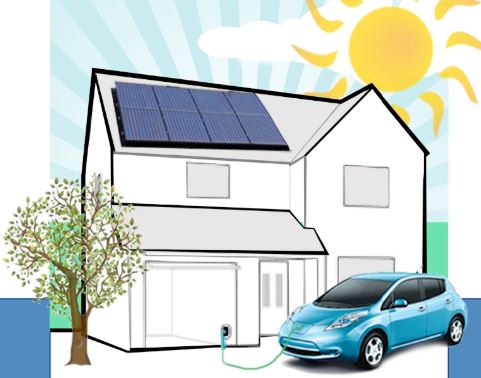It’s the season of long days, with increasing warmth, sunshine – and snowmelt in the Dungeness River.
The river rises to its peak in June in most years with normal snowpack, then gradually drops to its lowest flow in October before the rainy season starts and the next year’s snowpack savings account starts to grow again.
In years like this one with below normal snowpack, or when April and May are especially warm, the snowmelt peaks in May and disappears in August. After the snow is mostly melted the flow in the River relies on rain and “baseflow”: the groundwater bleeding into the river channel from the water table.
Coming from underground like a spring, baseflow is generally cool and provides good conditions for spawning salmon. The upside of the drizzly summer weather we’re having right now is this: every cool or wet day means the River’s lowest flow and warmest temperatures will be delayed a little longer.
Distributed energy
Summer solstice is Dave’s and my wedding anniversary. The day after is my birthday (and the day before is his, so we celebrate a lot).
Anyway, as I write this on the eve of departing for our celebratory adventure it’s also my birthday so I’m indulging in one of my favorite topics. Have I mentioned how much I love driving my electric car? Or that I especially love it when the car has been charged up by the sun?
These long days mean long hours of electricity pumping into our house from our 10-year-old solar panels on the roof. In the most radiation-intense middle of the day, our 14 panels don’t use up nearly all the energy generated unless we are running everything at once. The excess isn’t lost, however, but instead feeds into the PUD’s electricity grid and spins our meter backward.
PUD buys our excess power from us at the “wholesale” rate through a net metering agreement and we get a check from them once a year. It’s a good way to ensure our extra solar energy isn’t going to waste and nice to be contributing to the needs of our neighbors down the line.
That said, it’s more satisfying and economical to make good use of every electron our panels generate ourselves, such as for a big demand like charging a car battery. It makes a difference in our monthly PUD bill since whenever we charge the car after dark when the solar panels are asleep we’re using grid electricity at the retail rate.
When there’s daylight and I’m at home, I make sure my car is charging.
We’re very lucky to have the pleasure of driving on sunshine. We’re especially lucky because we’re very cheap: we didn’t sacrifice our savings account to buy our used solar panels because we had the one-time fortune of a small inheritance. We also didn’t spend much on our electric car, finding a 2014 model for less than $10,000 in 2017.
Our older EV’s battery is limited to about 80 miles, so about once every two weeks I must use our other car or risk not finding a charging station when and where I need one. It’s a lifestyle adjustment, though living on the edge has always had its appeal …
On the other hand, for a climate doomsayer like me, never having to pump gas is a big quality of life improvement. For a cheapskate like me, driving on free sunshine is a present that goes way past my birthday. And don’t it feel good!
Geek Moment
There’s a lot of important hydrologic interaction between the water table and the Dungeness River in the low-flow season of August to October. Baseflow coming out from the streambed is making up the vast majority of the flow at this time.
A fully-recharged water table will ooze water into the river and its side channels and keep options open for migrating salmon looking for places to spawn. Indeed, the “hyporheic” zone (the wetted gravels in the streambed) is where the bugs that salmon eat live, and where salmon eggs develop.
The dry cobblestones you see in the river channel later in summer may or may not be wet a few inches below, depending on the water table. But the water table suffers from low snowpack as much as the river since 25 percent of aquifer recharge comes through the riverbottom – mostly during the snowmelt season.
When flows are dangerously low for salmon then agricultural irrigation diversions are the first to be targeted for forbearance and conservation. Note, however, the combined effect of watershed residents conserving well water can also make a difference in the stability of the water table for recharging streams.
The circular-recycling theme surfaces again … everything is connected.
For the 2019 Water Year (started Oct. 1, 2018):
• Rain in Sequim through June 22 at the Sequim 2E weather station (sea level): Total rainfall = about 14 inches; Highest temperature= 75 deg. F on May 22; lowest temperature hasn’t changed = 15 deg. F in October.
• River flow at the USGS gage on the Dungeness (Mile 11.2): Max and min flows haven’t changed = 1,870 cubic feet per second (cfs) on Nov. 27 and 77 cfs on Oct. 25. Currently = 350 cfs. Range for the past month = 200-865 cfs.
• Flow at Bell Creek entering Carrie Blake Community Park: none; Bell Creek at Washington Harbor = flow for summer is 1-2 cfs.
# # #
Ann Soule is a hydrogeologist immersed in the Dungeness watershed since 1990, now Resource Manager for City of Sequim. The opinions expressed are those of the author and do not necessarily represent policies of her employer. Reach Ann at columnists@sequimgazette.com or via her blog at watercolumnsite.wordpress.com.
The above article was printed in the Sequim Gazette on June 26, 2019.

Driving on free sunshine! Love it!
LikeLike